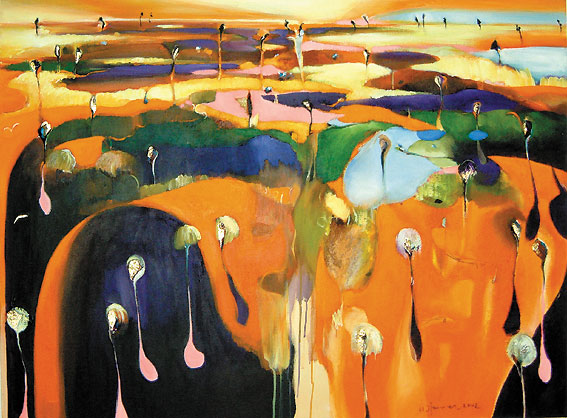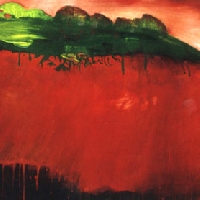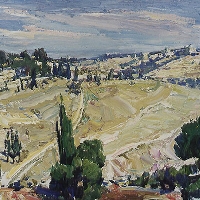German-born artist Nidhi Wiesner has experimented with different art forms, from Realism through to Figurative Expressionism and Abstract Art. She was educated at the Fine Art Institute in Cologne, the German Art capital. Her teacher, mentor and speaker at her first Vernissage at the Popplesdorf Gallery in Bonn in 1983, is the well-known artist Karl Marx. His influence and that of other European artists of the time (e.g. Bacon, de Kooning, Kiefer), among others, coupled with her love of travel and interest in Eastern meditation, has created a special mix and fuel to inspire her work over the last 25 years.
Recently, Wiesner has become increasingly attracted to a more semi-abstract expressionism, and in the past five years, it has been the harsh and mysterious landscape of Australia that has unexpectedly given this artist her required opening. Emigrating to Australia in 1994, the land has unleashed a passionate expression in Wiesners art. Perhaps there is a need for landscape painting, whether spiritual or physical, says Wiesner. Looking at land in general gives us a feeling of belonging and accommodation, but looking at our homeland, where we have grown up and lived can spark a stronger connection. We like to feel connected with the land in which we live or the land from which we originate.
It is difficult to feel at home in Australia, as you sense that the aboriginal people have had, and continue to have a much stronger relationship with the land, than many white Australians will ever have. To white Australians, there is a knowledge that there is a much more powerful source available to the indigenous artists as the history of white Australia is so short. Aboriginal work recurs throughout Australian art with a sense of a natural belonging, which serves as a benchmark to the historical efforts of settlement.
Australia, with its vast landscapes, never-ending spaces, the overwhelming power of the untamed and harsh landscape, has allowed Wiesner to vividly explore the intensity of colour and reflect an acute sensitivity to the surroundings. This period from 1994-2002, she calls her: Time of the Orange.
"Coming to Australia, I feel thrust into a new environment; an ancient land of pure nature; a primeval journey I feel the synthesis between the known and the mysterious. The intense lush green of the vegetation on the coastline, mixed with the warm brown solidity of the earth gave her the first ideas of this land.
I became more and more interested to pull the vast landscape with all its little trees together into a more abstract composition. Light and atmosphere are important. On the border range where I live, the fields and plains with its little tree-dots, reflect the light in a three-dimensional way. Gold appears where the reflection hits an object and colours are continuously changing. Their shadows move through the spectrum according to the kind of day, the time, and the seasons. Dominated by the plain, rather than by elevation, the space is wide and aerial, the valleys hidden; this is Australia
I use warm browns and reds to come emotionally close to this land. Digging in the earth and using the soil, little sticks, twigs and sand to build up a three-dimensional rough textured surface, thus infusing my work with the essence of the environment that I am painting.
Her latest series from 2001-2003 Fields of Home, documents a very deep search for her roots in Europe. These are the fields where everything began. Born 10 years after the war, in a Germany with its emotionally scarred landscapes, still trying to heal and rediscover its groundedness. Every stick that you see in her fields is like a person or a memory of someone she met in her life. Some of the scenes are more spiritual in nature, while others are much more down-to-earth.
Wiesner continually strives to achieve excellence in her draughtsmanship, composition and technique, and demonstrates a vibrancy, richness and confident use of colour. Her art is delicate and emotional, and this depth of understanding leaves the viewer stunned. The compositions challenge the way the viewer looks at the world and the nature. Her works are mostly completed landscapes drawn from reality and enriched through her imagination.
Nidhi Wiesner has exhibited her work in Sydney, Brisbane and Cologne, Germany as well as London, England. She has completed commissions for mayors, corporations and private individuals. When not furiously finding the time to paint, Nidhi Wiesner "commutes" between London, Cologne, India and Byron Bay, Australia.
QUOTES
All true artists, whether they know it or not, create from a place of no-mind, from inner stillness. The mind then gives form to the creative impulse or insight.
Eckhard Tolle
"Painting from nature is not copying the object; it is realizing one's sensations."
Paul Cezanne
There are painters who transform the sun into a yellow spot, but there are others
who with the help of their art and their intelligence, transform a yellow spot into the sun.
Pablo Picasso
If required, other quotes.
Art is long, life is short; judgement difficult, opportunity transient.
Goethe
All art is autobiographical; the pearl is the oyster's autobiography.
Federico Fellini
Every artist dips his brush in his own soul, and paints his own nature into his pictures.
Henry Ward Beecher
German-born artist Nidhi Wiesner has experimented with different art forms, from Realism through to Figurative Expressionism and Abstract Art. She was educated at the Fine Art Institute in Cologne, the German Art capital. Her teacher, mentor and speaker at her first Vernissage at the Popplesdorf Gallery in Bonn in 1983, is the well-known artist Karl Marx. His influence and that of other European artists of the time (e.g. Bacon, de Kooning, Kiefer), among others, coupled with her love of travel and interest in Eastern meditation, has created a special mix and fuel to inspire her work over the last 25 years.
Recently, Wiesner has become increasingly attracted to a more semi-abstract expressionism, and in the past five years, it has been the harsh and mysterious landscape of Australia that has unexpectedly given this artist her required opening. Emigrating to Australia in 1994, the land has unleashed a passionate expression in Wiesners art. Perhaps there is a need for landscape painting, whether spiritual or physical, says Wiesner. Looking at land in general gives us a feeling of belonging and accommodation, but looking at our homeland, where we have grown up and lived can spark a stronger connection. We like to feel connected with the land in which we live or the land from which we originate.
It is difficult to feel at home in Australia, as you sense that the aboriginal people have had, and continue to have a much stronger relationship with the land, than many white Australians will ever have. To white Australians, there is a knowledge that there is a much more powerful source available to the indigenous artists as the history of white Australia is so short. Aboriginal work recurs throughout Australian art with a sense of a natural belonging, which serves as a benchmark to the historical efforts of settlement.
Australia, with its vast landscapes, never-ending spaces, the overwhelming power of the untamed and harsh landscape, has allowed Wiesner to vividly explore the intensity of colour and reflect an acute sensitivity to the surroundings. This period from 1994-2002, she calls her: Time of the Orange.
"Coming to Australia, I feel thrust into a new environment; an ancient land of pure nature; a primeval journey I feel the synthesis between the known and the mysterious. The intense lush green of the vegetation on the coastline, mixed with the warm brown solidity of the earth gave her the first ideas of this land.
I became more and more interested to pull the vast landscape with all its little trees together into a more abstract composition. Light and atmosphere are important. On the border range where I live, the fields and plains with its little tree-dots, reflect the light in a three-dimensional way. Gold appears where the reflection hits an object and colours are continuously changing. Their shadows move through the spectrum according to the kind of day, the time, and the seasons. Dominated by the plain, rather than by elevation, the space is wide and aerial, the valleys hidden; this is Australia
I use warm browns and reds to come emotionally close to this land. Digging in the earth and using the soil, little sticks, twigs and sand to build up a three-dimensional rough textured surface, thus infusing my work with the essence of the environment that I am painting.
Her latest series from 2001-2003 Fields of Home, documents a very deep search for her roots in Europe. These are the fields where everything began. Born 10 years after the war, in a Germany with its emotionally scarred landscapes, still trying to heal and rediscover its groundedness. Every stick that you see in her fields is like a person or a memory of someone she met in her life. Some of the scenes are more spiritual in nature, while others are much more down-to-earth.
Wiesner continually strives to achieve excellence in her draughtsmanship, composition and technique, and demonstrates a vibrancy, richness and confident use of colour. Her art is delicate and emotional, and this depth of understanding leaves the viewer stunned. The compositions challenge the way the viewer looks at the world and the nature. Her works are mostly completed landscapes drawn from reality and enriched through her imagination.
Nidhi Wiesner has exhibited her work in Sydney, Brisbane and Cologne, Germany as well as London, England. She has completed commissions for mayors, corporations and private individuals. When not furiously finding the time to paint, Nidhi Wiesner "commutes" between London, Cologne, India and Byron Bay, Australia.
QUOTES
All true artists, whether they know it or not, create from a place of no-mind, from inner stillness. The mind then gives form to the creative impulse or insight.
Eckhard Tolle
"Painting from nature is not copying the object; it is realizing one's sensations."
Paul Cezanne
There are painters who transform the sun into a yellow spot, but there are others
who with the help of their art and their intelligence, transform a yellow spot into the sun.
Pablo Picasso
If required, other quotes.
Art is long, life is short; judgement difficult, opportunity transient.
Goethe
All art is autobiographical; the pearl is the oyster's autobiography.
Federico Fellini
Every artist dips his brush in his own soul, and paints his own nature into his pictures.
Henry Ward Beecher

2002
Mixed media /gold on canvas
122 x 91cm, (48" x 35 3/4")
Price: POA
































